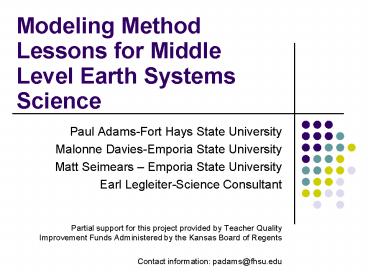Modeling Method Lessons for Middle Level Earth Systems Science - PowerPoint PPT Presentation
1 / 27
Title:
Modeling Method Lessons for Middle Level Earth Systems Science
Description:
Modeling is an instructional design program that creates a learner centered environment ... of Modeling Instruction ... Earth science Modeling (1week) ... – PowerPoint PPT presentation
Number of Views:94
Avg rating:3.0/5.0
Title: Modeling Method Lessons for Middle Level Earth Systems Science
1
Modeling Method Lessons for Middle Level Earth
Systems Science
- Paul Adams-Fort Hays State University
- Malonne Davies-Emporia State University
- Matt Seimears Emporia State University
- Earl Legleiter-Science Consultant
- Partial support for this project provided by
Teacher Quality Improvement Funds Administered by
the Kansas Board of Regents - Contact information padams_at_fhsu.edu
2
Presentation Overview
- Introduction to Modeling instruction
- Structure of the workshops
- Earth systems and space science unit development
- Look at middle school earth systems/space science
units
3
Introduction to Modeling Instruction
4
What is Modeling?
- Modeling is an instructional design program that
creates a learner centered environment - An Inquiry approach introduces concepts
- Students construct in-depth understanding of
scientific models using deployment activities - Research supports its effectiveness
- Only high school instructional program recognized
as exemplary by US Department of Education
5
Objectivesof Modeling Instruction
- Construct and use scientific models to describe,
to explain, to predict and to control physical
phenomena - Model physical objects and processes using
diagrammatic, graphical, and mathematical
representations - Small set of basic models as the content core of
science - Modeling as the procedural core of scientific
knowledge
6
(No Transcript)
7
Modeling Cycle
- Development begins with paradigm experiment
- Experiment itself is not remarkable
- Instructor sets the context
- Instructor guides students to
- identify system of interest and relevant
variables - discuss essential elements of experimental design
8
I - Model Development
- Students in cooperative groups
- design and perform experiments
- use computers to collect and analyze data
- develop science concept understanding from
inquiry
9
I - Model Development
- Post-lab analysis
- whiteboard presentation of student findings
- multiple representations
- verbal
- diagrammatic
- graphical
- algebraic
- justification of conclusions
10
II - Model Deployment
- In post-lab extension, the instructor
- brings closure to the experiment
- fleshes out details of the model, relating common
features of various representations - helps students to abstract the model from the
context in which it was developed
11
II - Model Deployment
- In deployment activities, students
- learn to apply model to variety of related
situations
12
(No Transcript)
13
Sense Making Opportunity
- Whiteboard discussions
MacIsaac, 2003
14
Why Modeling?
- Objectives
- to improve the quality of scientific discourse
- move toward progressive deepening of student
understanding of models and modeling with each
pass through the modeling cycle - get students to see models everywhere!
15
Effectiveness of Modeling MethodFCI Scores
16
Modeling Instruction Program
check out our home page http//modeling.asu.
edu/
17
Structure of the Workshops
18
Structure of the Workshop
- Funded by Improving Teacher Quality Partnership
Grant administered by KBOR - Three year project
- Two universities
- Fort Hays State University
- Emporia State University
19
Project Personnel
- FHSU
- Paul Adams
- Zdeslav Hrepic
- Eddie Olmstead
- Beth Walizer
- Stella Ollarsaba
- Earl Legleiter
- ESU
- Malonne Davies
- Matt Seimears
- Douglas Rickard
- Brad Cline
- Suzi Shoemaker
20
Structure of the Workshop
- Year one (July 05)
- Introduction to Modeling
- Three weeks
- Physical Science and Mathematical models
- Year two (July 06)
- Chemistry Modeling (1 week)
- Modeling unit development (2 weeks)
- Year three (July 07)
- Earth science Modeling (1week)
- Earth/space, environmental, and biological unit
development (2 weeks)
21
Use of Technology
- Vernier probeware
- Vernier graphical analysis
- Simcalc
- Marratech
- IPTV video-conferencing
22
Follow-up Activities
- October Meeting
- Saturday return to university
- Assist with implementation
- Equipment pick-up
- April Meeting
- KATS Kamp
- Group sharing and presentations
- School Visitations
- Hosted by participating schools
23
Participant support
- Stipends
- Tuition
- 500 technology for schools
24
Earth Systems and Space Science Unit Development
25
Earth System and Space Science Unit Development
- Understanding by Design guides unit development
- Developed laboratory and deployment activities
- Test with middle school students
- Presented units via IPTV conferencing
- http//www.fhsu.edu/zhrepic/Teaching/Workshops/Mo
deling/Participant_Units/PD_Units_Index.htm
26
Middle School Earth Systems/Space Science Units
27
Middle School Earth Systems/Space Science Units
- All units available at
- http//www.fhsu.edu/zhrepic/Teaching/Workshops/Mo
deling/Participant_Units/PD_Units_Index.htm - See handout































